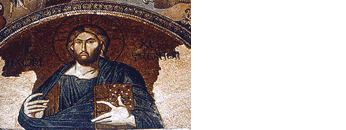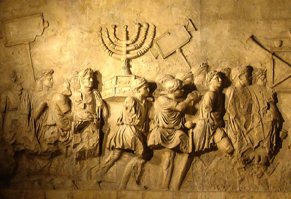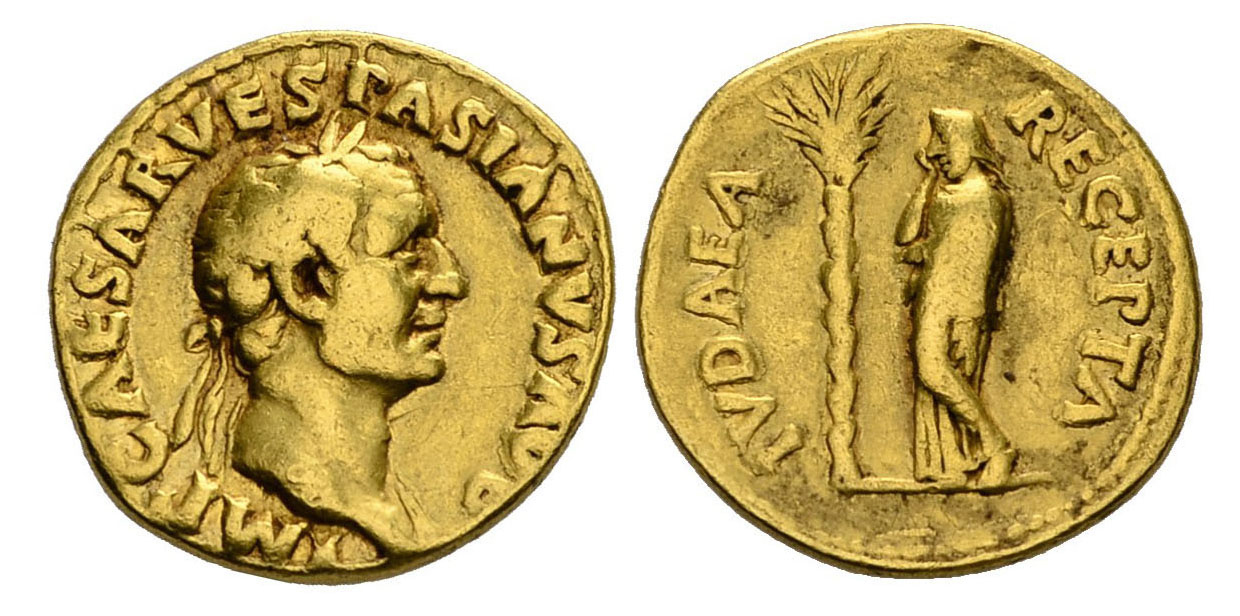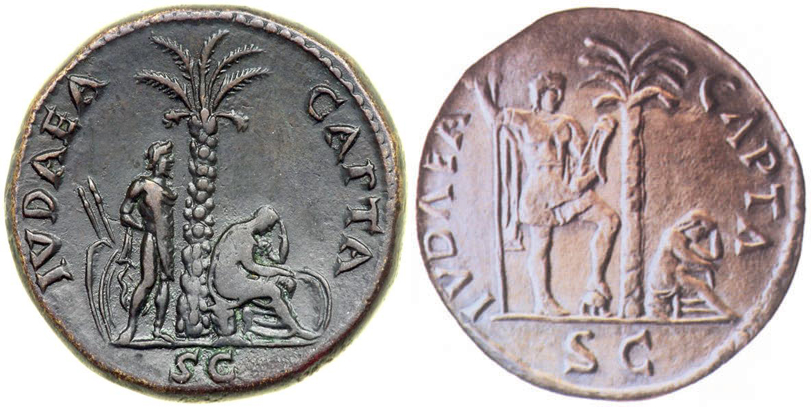
|
|
|
|
|
Artifact Analysis
|
|
|
|
- Weapons & Art of the Jewish Revolt
-

The First Jewish Revolt (66-74 CE) entailed battles thoughout Palestine, the siege of Jerusalem and destruction of its Second Temple, and the rise of the victorious Roman general Vespasian and his son Titus as the new imperial dynasty in Rome (the Flavians). Following Roman custom, Titus plundered the Jerusalem Temple and brought back the booty, including Jewish slaves, to Rome for his triumph (victory parade). He then commemorated his victory by building the Arch of Titus, on which his artists depicted his triumph, with captured slaves carrying the Temple trumpets and menorah (candelabra). The Arch still stands in the Forum Romanum just behind the Flavian Amphitheatre (Colosseum).-
 Recently, some very interesting evidence has come to light that suggests Roman disagreement about how to portray their victory in Palestine. Titus, as we know from the arch above, may have rushed to proclaim Judea to be again "under the yoke" ("Judaea recepta" on the coin above right), a designation usually reserved to provinces that had been recaptured. Recently, some very interesting evidence has come to light that suggests Roman disagreement about how to portray their victory in Palestine. Titus, as we know from the arch above, may have rushed to proclaim Judea to be again "under the yoke" ("Judaea recepta" on the coin above right), a designation usually reserved to provinces that had been recaptured. -
 But this view of the Roman victory was reevaluated, most likely by Titus' father Vespasian. Instead of considering Judea a province that had been recaptured, they designated it a province captured for the first time, which implied that it had never been a friendly state (see the "Judaea capta," or captive Judea images above). But this view of the Roman victory was reevaluated, most likely by Titus' father Vespasian. Instead of considering Judea a province that had been recaptured, they designated it a province captured for the first time, which implied that it had never been a friendly state (see the "Judaea capta," or captive Judea images above).-
- In addition to the propaganda of victory, the tools of Rome's military dominance are the siege engines, catapults (with ammunition like the large stone spheres above), ballista (above right) for shooting spears to greater distances, and weapons of the time. Many of these were found in sites around Israel, or were described and depicted in contemporary literature and art.
-
-
-
- Bibliography
-
- Monumental Art
-
- Aitken, Ellen Bradshaw. "Portraying the Temple in Stone and Text: The Arch of Titus and the Epistle to the Hebrews." In Hebrews: Contemporary Methods— New Insights (ed. Gabriella Gelardini; Biblical Interpretation 75; Boston: Brill, 2005) 131-48. Originally published in Religious Texts and Material Contexts (ed. Jacob Neusner and James F. Strange; Studies in Ancient Judaism; Lanham, Maryland: University Press of America, 2001) 73-88, and thereafter with a concluding section in Sewanee Theological Review 45:2 (2002) 135-51.
-
- Gjødesen, Mogens. "A Fragment of the Arch of Titus." In Studia Romana in honorem Petri Krarup Septuagenarii (ed. Karen Ascani, Tobias Fischer-Hansen, Flemming Johansen, Søren Skovgaard Jensen and Jens Erik Skydsgaard; Odense: Odense University Press, 1976) 72-86.
-
- Henderson, John. "Par Operi Sedes: Mrs. Arthur Strong and Flavian Style, The Arch of Titus and the Cancelleria Reliefs." In Flavian Rome: Culture, Image, Text (ed. A. J. Boyle and W. J. Dominik; Boston: Brill, 2003) 229-54.
-
- Holloway, R. Ross. "Some Remarks on the Arch of Titus." L'antiquité Classique 56 (1987) 183-91.
-
- Kon, M. "The Menorah of the Arch of Titus." Palestine Exploration Quarterly 82 (1950) 25-30.
-
- Magness, Jodi. "The Arch of Titus at Rome and the Fate of the God of Israel." Journal of Jewish Studies 59:2 (2008) 201-217.
-
- Millar, Fergus. "Last Year in Jerusalem: Monuments of the Jewish War in Rome." In Flavius Josephus and Flavian Rome (ed. Jonathan Edmondson, Steve Mason and James B. Rives; Oxford: 2005) 101-128.
-
- Ostenberg, Ida. Staging the World: Spoils, Captives,and Representations in the Roman Triumphal Procession, Oxford Studies in Ancient Culture & Representation. New York: Oxford University Press, 2009.
-
- Yarden, Leon. The Spoils of Jerusalem on the Arch of Titus: A Re-Investigation, Skrifter utgivna av Svenska Institutet i Rom, 8° 16. Stockholm: Svenska Institutet i Rom, 1991.
-
- --------. "Work in Progress. The Spoils of Jerusalem on the Arch of Titus. A Reinvestigation." Opuscula Romana 14 (1983) 101-102.
-
-
- Coins of Victory
-
- Cody, J. M. "Conquerors and Conquered on Flavian Coins." In Flavian Rome: Culture, Image, Text (ed. A. J. Boyle and W. A. Dominik; Boston: E. J. Brill, 2003) 103-123.
-
- Gambash, Gil. "Foreign Enemies of the Empire: The Great Jewish Revolt and the Roman Perception of the Jews." Scripta Classica Israelica 32 (2013) 173-94.
-
- --------. "Official Roman Responses to Indigenous Resistance Movements: Aspects of Commemoration." In Israel's Land: Papers Presented to Israel Shatzman on His Jubilee (ed. Joseph Geiger, Hannah M. Cotton and Guy D. Stiebel; Raʿanana-Jerusalem: The Open University of Israel/Israel Exploration Society, 2009) 53*-76*.
-
- Gambash, Gil, Haim Gitler and Hannah Cotton. "Iudaea Recepta." Israel Numismatic Research 8 (2013) 89-104.
-
-
- Weapons
-
- Aviam, Mordechai. "The Archaeological Illumination of Josephus' Narrative of the Battles at Yodefat and Gamla." In Making History: Josephus and Historical Method (ed. Zuleika Rodgers; Supplements to the Journal for the Study of Judaism 110; Boston: Brill, 2007) 372-84.
-
- Davies, Gwyn. "Under Siege: The Roman Field Works at Masada." Bulletin of the American Schools of Oriental Research 362 (2011) 65-83.
-
- Levithan, Joshua C. "The Roman Siege" and "The Siege of Jerusalem in The Jewish War." In "Siege Warfare and Combat Motivation in the Roman Army" (Ph.D. Thesis, Yale University, 2007) 114-63, 193-224.
-
-
-
|
|
|
|
|
